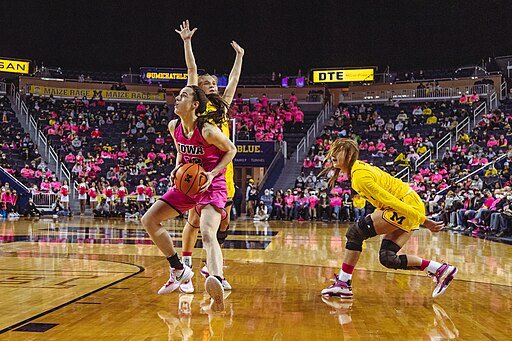Women’s Basketball Hype Here to Stay, but Issues Remain
Caitlin Clark playing at the University of Michigan. Photo from MGoBlog, CC BY-SA 2.0, via Wikimedia Commons
On paper, the future of women’s basketball in the U.S. has never been brighter.
Caitlin Clark, whose high-volume 3-point shooting has drawn comparisons to Steph Curry, has catapulted the sport to the forefront of national consciousness. Her four-year run with the Iowa Hawkeyes was undoubtedly one of the greatest ever from a collegiate athlete. She capped it off by averaging a scintillating 31.6 PPG during her senior year, the best in the nation by a country mile. Her run was further cemented when the Indiana Fever selected her with the first overall pick in the WNBA draft.
It hasn’t just been a one-woman show, either. UConn’s Paige Bueckers gave the nation a classic comeback arc to fawn over after returning from an ACL injury to lead the Huskies to the Final Four. And who can forget Angel Reese, the rebounder who broke the LSU program record for consecutive double-doubles, especially after she led the Tigers in a toe-to-toe Elite Eight bout against Clark’s Hawkeyes.
The proof is in the pudding. With a phenomenal product on the court, viewership records were shattered week after week during March Madness. The Elite Eight matchup between LSU and Iowa broke the record for the women’s college tournament by averaging 12.3 million viewers, and then that record was broken just days later in the Iowa-UConn semifinal when an average of 14.2 million viewers tuned in.
The watershed moment for women’s basketball came in the NCAA championship game, as the matchup between Iowa and South Carolina completely obliterated the viewership record by drawing an average of 18.7 million viewers and peaking at a whopping 24 million viewers. Not only did this game set the viewership record for the women’s tournament, it even outdrew the men’s championship game for the first time ever.
The momentum from March Madness has carried over to the WNBA; it was announced that Indiana Fever will play in 36 nationally televised games this season after it became apparent that they would be the team to draft Clark first overall. Even the Fever’s opponents have benefitted from Clark’s influence; the Washington Mystics made the decision to move their June 7 game against the Fever from their 4,000-seat home arena to the 20,000-seat Capital One Arena due to an unprecedented amount of demand from the D.C.-area fans wishing to see Clark play.
With women’s hoops seemingly on the upswing, it would be fair to conclude that a group of female hoopers has finally broken through to achieve the same level of status and influence as their male counterparts.
Yet, issues still remain.
Increased exposure for these athletes has resulted in them being subjected to racism, sexism and harassment from male pundits and spectators, both in the media and online.
LSU head coach Kim Mulkey made waves when she called out L.A. Times columnist Ben Bolch during a March 31 press conference. Bolch had referred to Mulkey’s predominantly Black team as “villains,” “Louisiana Hot Sauce” and “dirty debutantes'' in a scathing article. After a torrent of backlash, Bolch subsequently issued a lengthy apology, and the L.A. Times issued a correction, noting that the language used to describe LSU’s players was not up to their standards.
Even more disgusting and horrifying was the sexual harassment that both Clark and Bueckers were subjected to on social media on April 21; explicit images of both athletes were created using artificial intelligence, and they began heavily circulating on X and Reddit.
“The devil works hard but God and the people around me work WAY harder. The outpouring of love and support from the WBB community is unreal. Love y’all. Support women in sports ALWAYS,” Bueckers posted on X in the wake of the photos surfacing.
“Protect young women in sports!!!” Reese wrote in an X post of her own.
Yet another issue plaguing the sport is the lack of gender parity when it comes to player salaries. The imbalance in player salaries between the NBA and WNBA can be directly attributed to the revenue disparities between each league; the NBA took in $10 billion worth of revenue in 2023, while the WNBA only made around $200 million as a league. Consequently, WNBA players get paid less. Victor Wembanyama, the most recent first-overall pick in the NBA draft, took home a rookie year salary of over $12 million. On the contrary, Clark will only make $76,535 during her rookie season, a salary comparable to an entry-level engineer.
Despite these inequities, hope is on the horizon. The swift backlash to the harassment players have endured online and in the media is an indication that American society has far less tolerance for discrimination in women’s sports than it once did. As Clark and company continue to establish their presence over the long haul, the opportunity exists to dramatically improve the way female athletes are portrayed in the media and in casual conversations.
And when it comes to pay, the WNBA’s recent surge in ticket demand and national TV broadcasts is sure to bring in vast amounts of new revenue that ought to immediately filter into the players’ pockets.
In the meantime, Clark and her counterparts have begun to leverage their celebrity status into brand deals to help bridge the financial gap. Clark just signed a $28 million deal with Nike that will include a signature shoe, demonstrating that her on-court success and off-court influence have translated into commercial gains.
At this point in time, some things within the world of women’s basketball are abundantly clear: the people responsible for putting women’s hoops on the map aren’t going anywhere, and they have the numbers to back it up.
